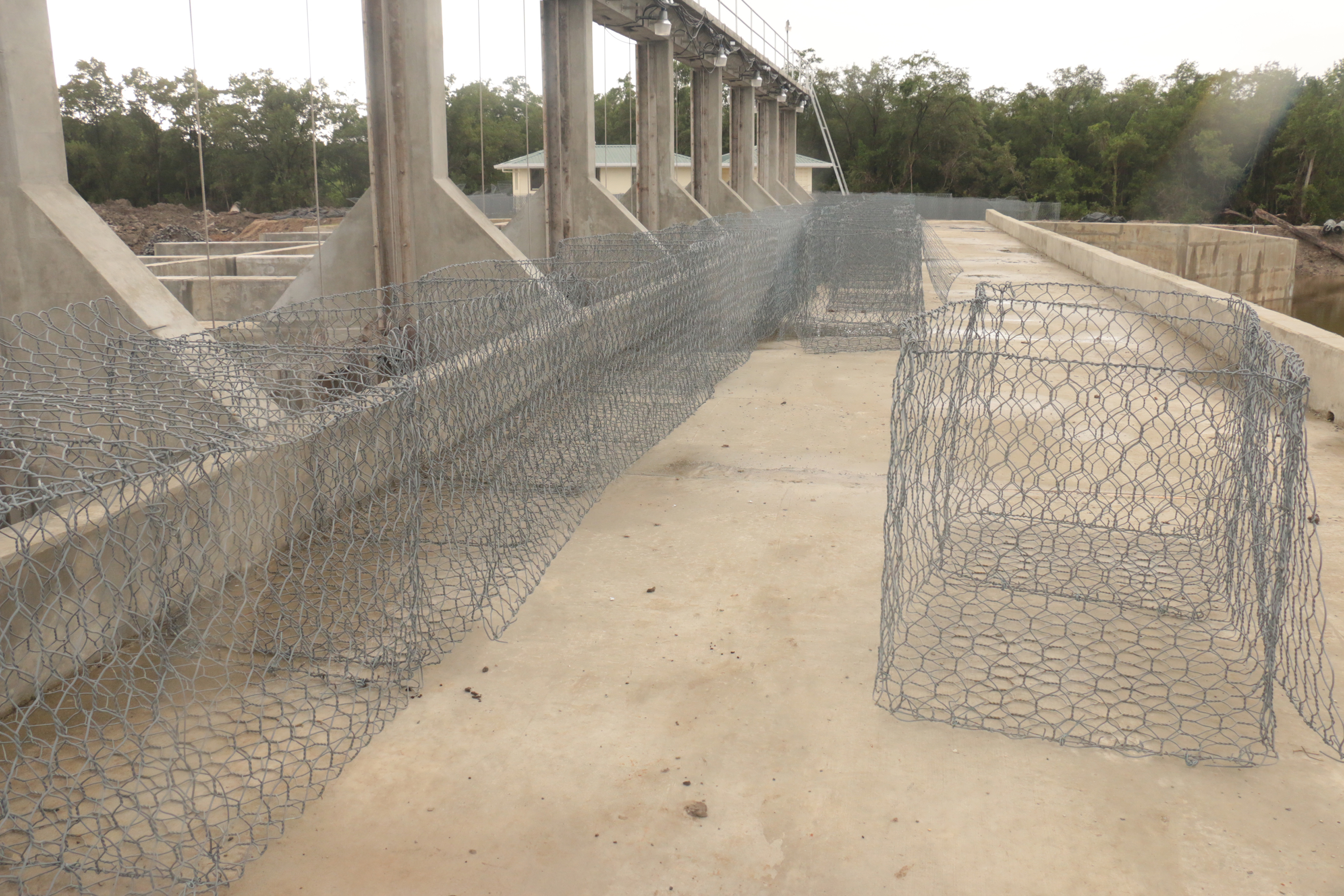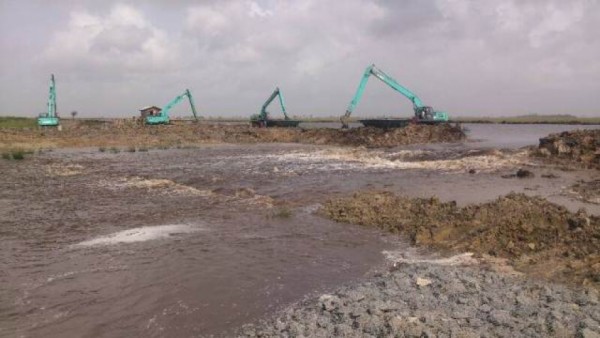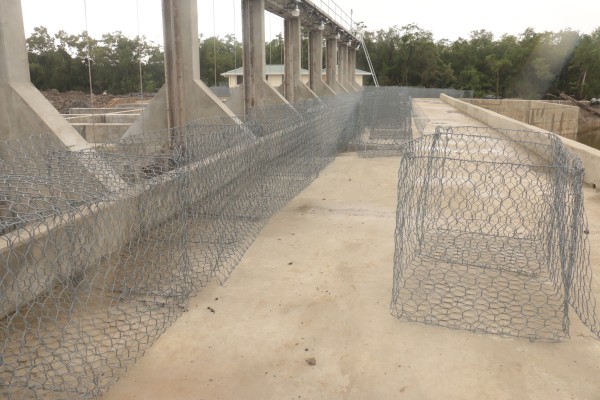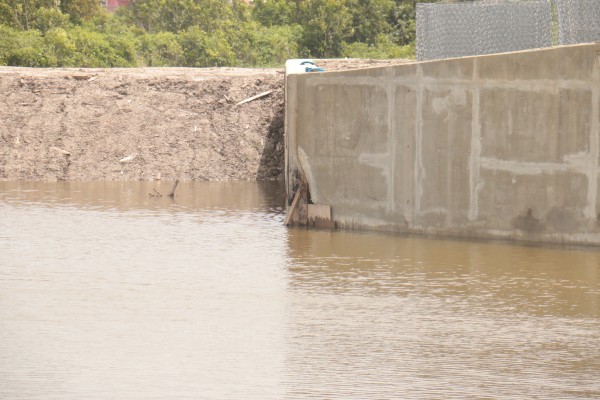Over four years after construction began, the $3.6 billion Hope Canal was tested for the first time yesterday and assisted in lowering water levels in the East Demerara Water Conservancy (EDWC).
The test is to continue today and if it proves successful, the canal will be used as required during the current rainy season until construction is completed, which is projected to be in August.
The test involved the opening of the head regulator at the EDWC, which was done yesterday morning. Discharge of water into the Atlantic Ocean through the eight-door sluice was also expected to be done but the water did not reach to the level expected and the outlet was only opened briefly late yesterday when the Minister of Agriculture Noel Holder visited and some water was discharged.
The head regulator was eventually closed late yesterday and Head of the National Drainage and Irrigation Autho- rity (NDIA) Lionel Wordsworth told Stabroek News that it would be reopened today, with release of water into the ocean expected to be done from about 10AM.
The water level in the EDWC, which was at 58.25 GD (Georgetown Datum – a unit of measurement) early yesterday, had dropped to 58.15 GD by late yesterday, Wordsworth said. He noted that apart from the Hope Canal, water was being discharged from the EDWC into the Land of Canaan, Kofi, and Cunha canal sluices. The height of the EDWC dam is 59 GD.
The Agriculture Minis-try on Friday said the decision to test the canal was taken in light of the fact that the EDWC level has risen to a threatening height as a result of recent rainfall. As a last resort, the Ministry had also said that the EDWC commission would take a decision to have controlled release of water through the Mahaica Creek, via the Lama and Maduni outlets, so as to ensure the integrity of the conservancy’s dams. In the past, this has led to severe flooding of the Mahaica Creek and surrounding areas. This was not done yesterday.
Yesterday’s testing of the canal involved clearing away 25 feet of material from the EDWC dam to a depth of two feet, thus creating an opening to the head regulator and enabling water from the conservancy to enter the channel of the Hope Canal. Only one gate of the three-door regulator was opened initially, Wordsworth said. “It gives us that gradual opportunity of lifting the water and also to do the monitoring that we want to do,” he explained.
Officials were looking to raise the water in the Hope Canal channel to 56 GD firstly, make assessments, then raise it to 57 GD. Based on further assessments at that point, they would make a decision as to whether they could raise the water level to 57.5 GD. “It’s the first time we’re putting flows through it and it is only correct that we take these precautionary measures at these various levels to do an assessment,” Wordsworth said.
He said that when the water level in the canal rises to between 56 and 57 GD, they would have released water into the ocean via the eight-door sluice. However, up to last evening the water level in the canal was at 55.5 GD and the head regulator was closed.
Wordsworth said that they would not do night discharges from the EDWC into the Hope Canal for now.
Yesterday, a portion of land that remained in place at the outfall to prevent water from the ocean from flowing to the seven-door sluice was partially cleared. Some work remains to be done at the outlet, including to create an outfall channel and put in place scour protection on the embankments at the eight-door sluice. Prior to yesterday’s exercise, the gates at the sluice were tested to see if they worked and it went smoothly, Stabroek News was told.
Wordsworth noted that the entire objective of yesterday’s exercise was to test but more importantly to bring water levels in the EDWC to 58 GD and below.
He said that once successful, the canal would be utilised when necessary. “The works to be completed and for the purpose we’re using it now wouldn’t be no significant effect onto what’s left to be completed,” the NDIA head said. He noted that once they are able to get the conservancy level manageable and are out of the rainy season, it would be “very easy” for the entire project to be completed.
Wordsworth also told Stabroek News that once the rainy season is over, it would take about eight weeks for the project to finally be completed. Pressed on a deadline, he said that the project should be fully completed in August, once the rainy season is not prolonged.
The canal was one of the major projects of the 2006 Bharrat Jagdeo administration in the aftermath of the 2005 Great Flood. However, it has encountered severe delays and the life of the 2011 Donald Ramotar administration expired without it being commissioned.
Conceived following the Great Flood, the controversial project was designed to drain water from the EDWC into the Atlantic Ocean, thereby eliminating the flooding of the Mahaica Creek and its environs. It has missed many deadlines, including the original 18-month period for construction after it was commenced in February, 2011. The time frame was extended from June, 2013 to August, then to December, then to June 2014, then to September and again to December. In January of this year, former Cabinet Secretary Dr Roger Luncheon blamed cost overruns for the last missed deadline. He had said that most of the work was completed although at that time the eight-door sluice was still to be completed.
The Hope Canal Project has four components: the Northern Relief channel, which will be 10.3km in length from the sea defence embankment and extending to the EDWC; a high level outfall sluice; a conservancy head regulator; and a public bridge.








